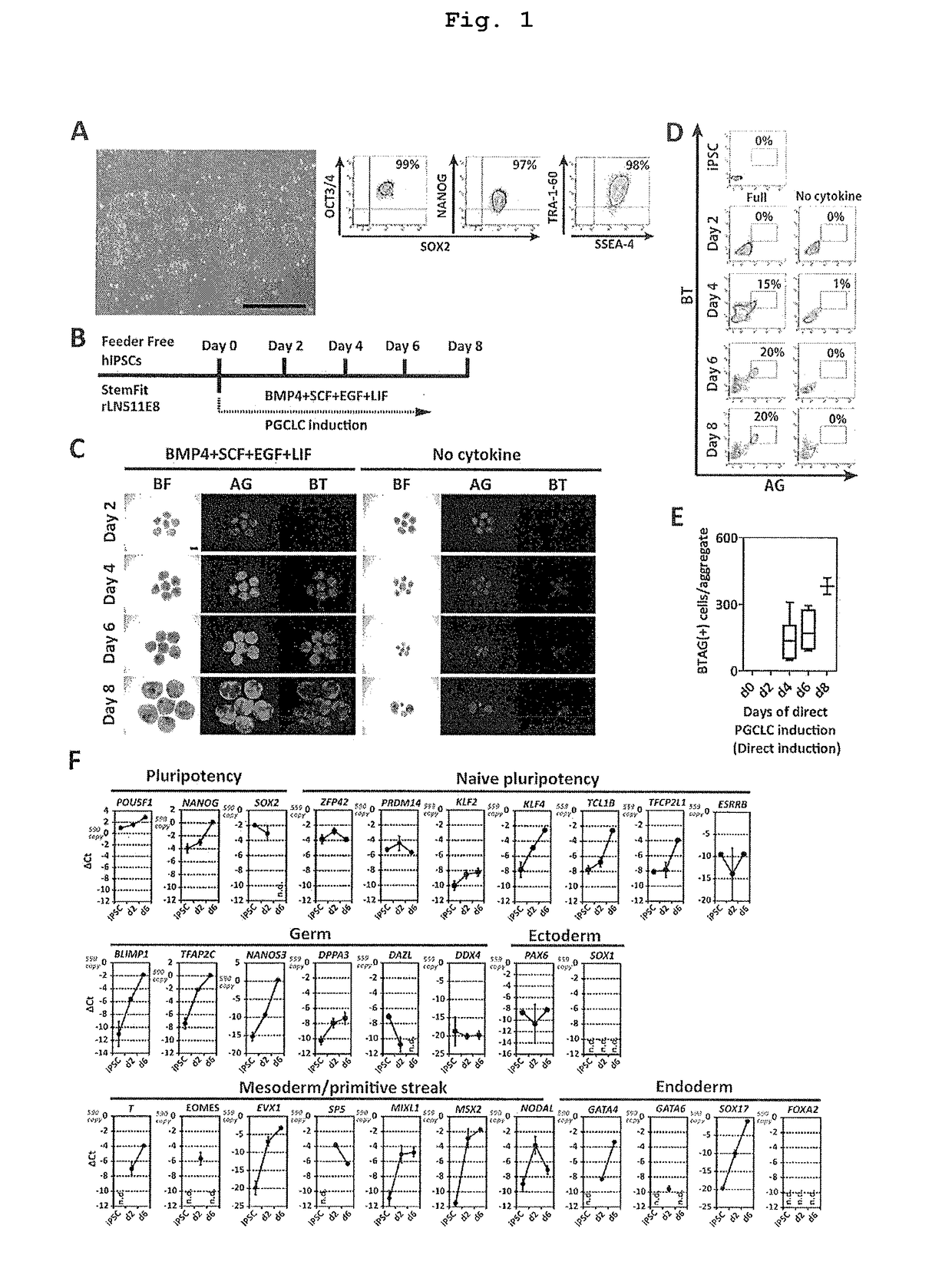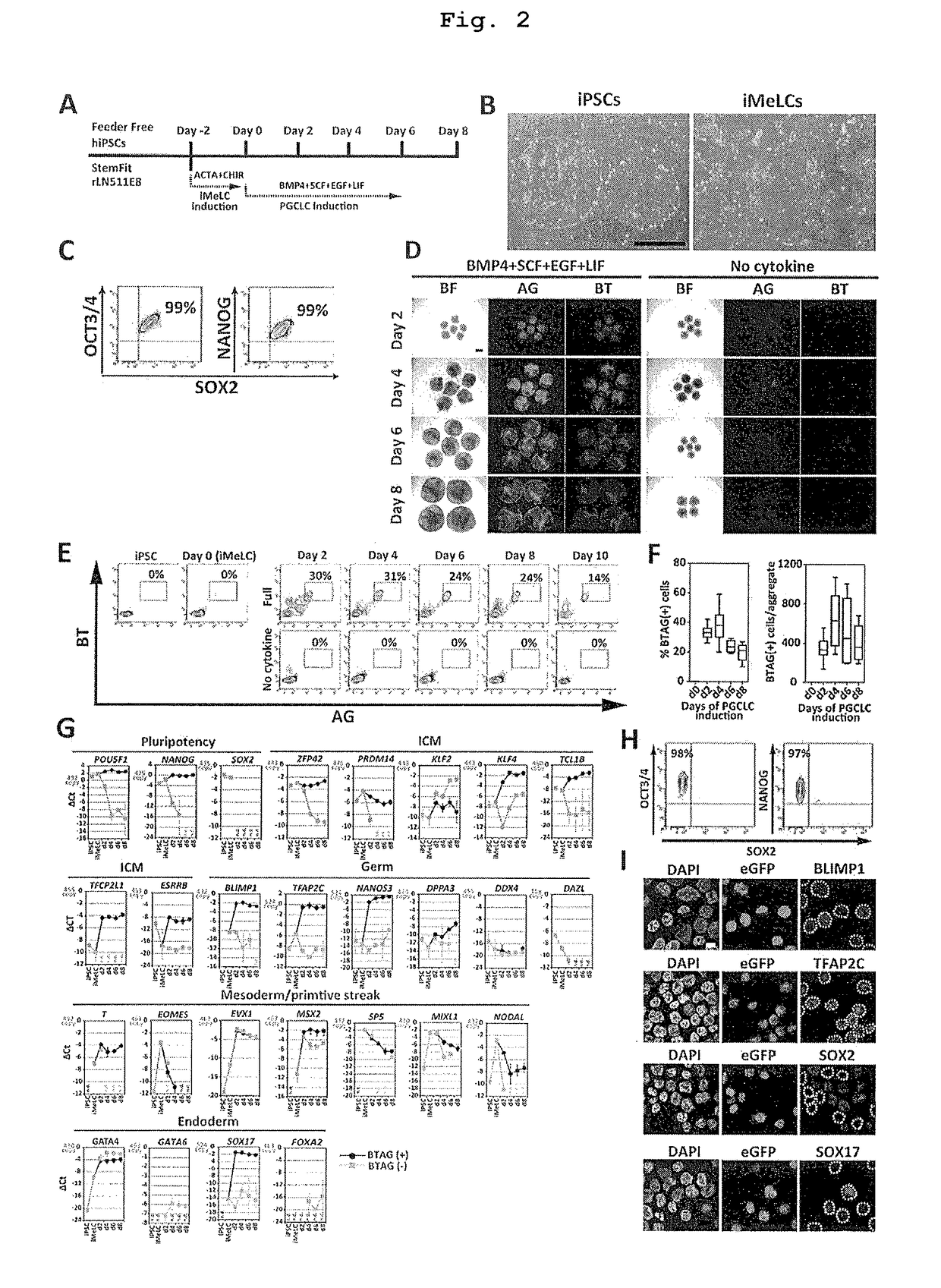Method for inducing differentiation of pluripotent stem cells into germ cells
a technology of germ cells and stem cells, which is applied in the field of inducing the differentiation of pluripotent stem cells into germ cells, can solve the problems of difficult diagnosis/treatment of diseases caused by defects in human germ cells, low efficiency of random differentiation of hescs/ipscs, and difficulty in obtaining experiment materials, etc., to achieve high efficiency, suppress the development of dead cells, and increase the induction efficiency of human pgc-like cells
- Summary
- Abstract
- Description
- Claims
- Application Information
AI Technical Summary
Benefits of technology
Problems solved by technology
Method used
Image
Examples
experiment method
Ethical Guidelines
[0130]All animal experiments were performed according to the ethical guidelines of Kyoto University and Siga University of Medical Science. The induction experiments from hiPSCs into hPGCLCs were approved by the Kyoto University Institutional Review Board (Institutional Ethics Committee).
Culture of hiPSCs
[0131]hiPSC strains (201B7, 585A1, 585B1) (Takahashi K, et al., Cell. 131, 861-872, 2007 and Okita K, et al., Stem Cells. 31, 458-466, 2013) were subjected to maintenance culture under mitomycin C (MMC)-treated SNL feeder cell by a conventional method [Dulbecco's Modified Eagle Medium (DMEM / F12; Life Technologies) added with 20% (v / v) Knockout Serum Replacement (KSR; Life Technologies), 1% GlutaMax (Life Technologies), 0.1 mM non-essential amino acid, 4 ng / ml recombinant human bFGF (Wako), and 0.1 mM 2-mercaptoethanol], and then adapted to feeder-free conditions [on recombinant laminin511 (rLN511E8) (iMatrix-511, Nippi)-coated cell culture plate, StemFit™ (Ajinomot...
example 1
[0152]Establishment of hiPSCs Having Dual Germ Line Reporter
[0153]To examine in vitro induction conditions for differentiation from hiPSCs into germ cells, hiPSC strain having reporter for BLIMP1 (also known as PRDM1) and TFAP2C (also known as AP2γ) was established. BLIMP1 and TFAP2C were considered to be useful since expression in human germ cell has been reported (Eckert D, et al., BMC Dev Biol. 8, 106, 2008 and Pauls K, et al., Int J Cancer. 115, 470-477, 2005).
[0154]In this case, 585A1 and 585B1, which are two line independent straoms of male hiPSC derived from peripheral mononuclear blood cells were used as hiPSC (Okita K, et al., Stem Cells. 31, 458-466, 2013). This cell line was cultured on E8 fragment (rLN511E8) of recombinant laminin511 in a given medium containing basic fibroblast growth factor (bFGF), whereby single cell passage culture with colony forming ability became possible (Nakagawa M, et al., Sci Rep. 4, 3594, 2014). hiPSCs cultured under such conditions showed mo...
example 2
Strong Induction of BTAG Positive Cell Via Initial Mesoderm-Like State
[0160]While BTAG positive cells are directly induced from hiPSCs, cell aggregates contained a considerable number of dead cells, and the amount of the obtained BTAG positive cells was comparatively small (FIG. 1E). Direct induction of germ cell differentiation via formation of floating T cell aggregation may not be an optimal pathway. Thus, the conditions for inducing hiPSCs into an appropriate precursor for germ cell differentiation induction were studied. Prior to germ cell differentiation, based on the finding of the activation of induction into mesoderm lineage induced by BMP4 and WNT3 signal in mouse (Aramaki S, et al., Dev Cell. 27, 516-529, 2013 and Saitou M, et al., Nature. 418, 293-300, 2002), the effect of previously contacting hiPSCs with BMP4, WNT3 and other signaling molecule, which is similar to the use of various extracellular matrix (ECM) constituent components, was examined for induction of a prec...
PUM
| Property | Measurement | Unit |
|---|---|---|
| temperature | aaaaa | aaaaa |
| diameter | aaaaa | aaaaa |
| time | aaaaa | aaaaa |
Abstract
Description
Claims
Application Information
 Login to View More
Login to View More - R&D
- Intellectual Property
- Life Sciences
- Materials
- Tech Scout
- Unparalleled Data Quality
- Higher Quality Content
- 60% Fewer Hallucinations
Browse by: Latest US Patents, China's latest patents, Technical Efficacy Thesaurus, Application Domain, Technology Topic, Popular Technical Reports.
© 2025 PatSnap. All rights reserved.Legal|Privacy policy|Modern Slavery Act Transparency Statement|Sitemap|About US| Contact US: help@patsnap.com



